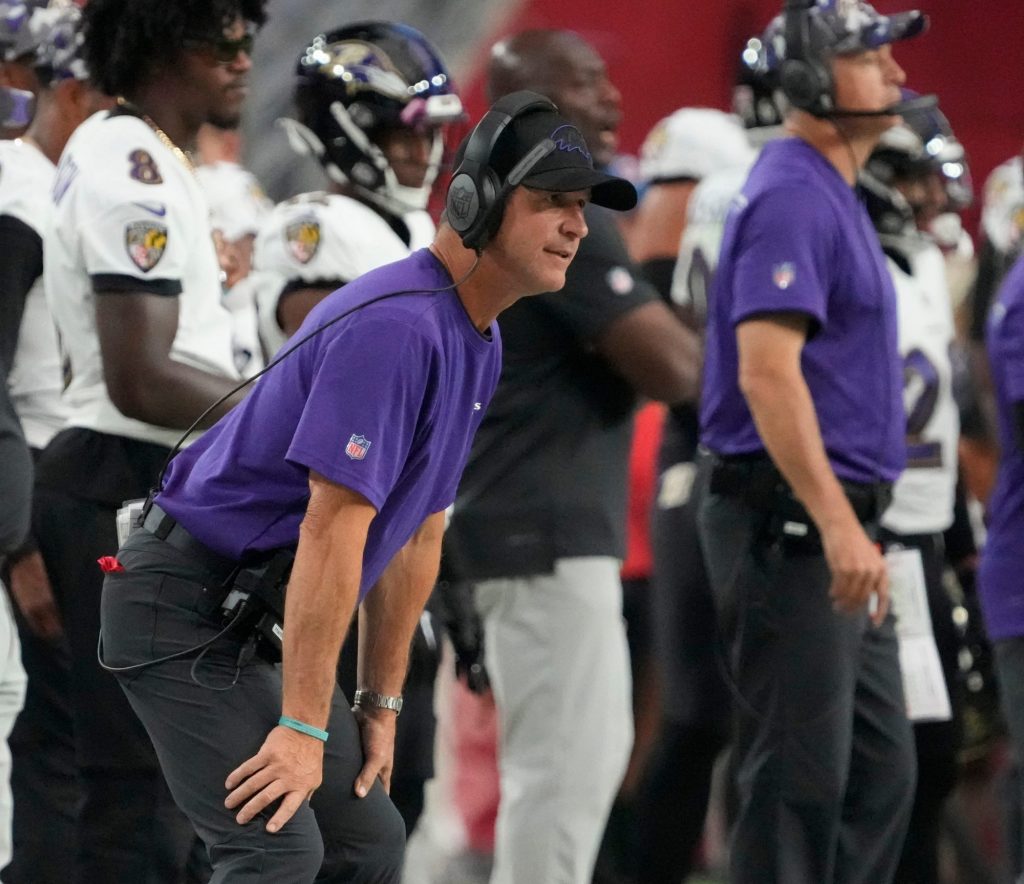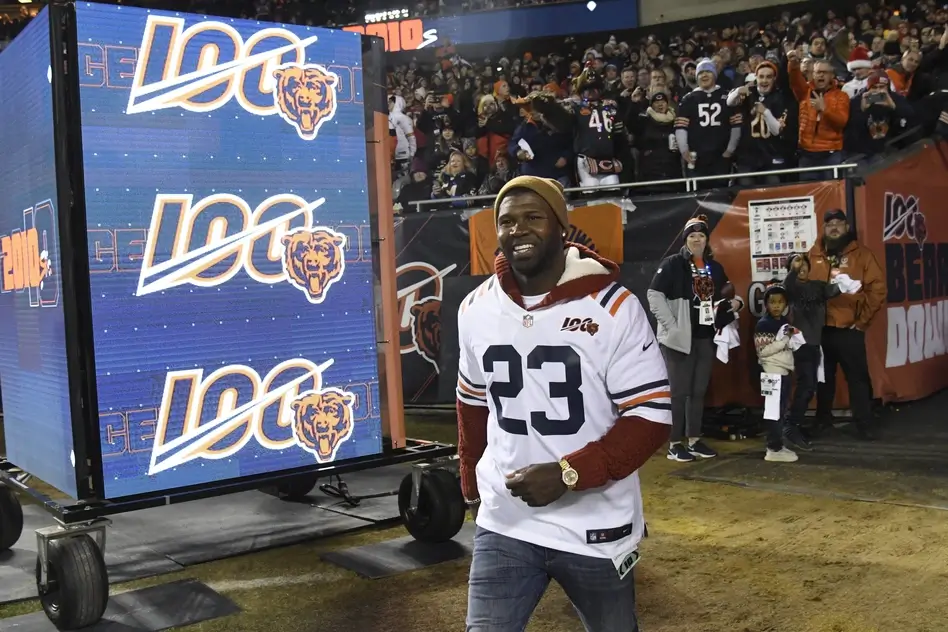Even if it’s one of the most fundamental aspects of playing the game, most football fans need to have NFL formations explained to them.
There are even some fans that need NFL positions explained since different positions have to lineup in different parts of the field.
NFL formations explained
That’s why we wanted to put together an NFL formations guide for anyone who needs NFL plays explained starting with the pre-snap formation.
How do formations work in football?
Our NFL formations guide begins with understanding that formations are typically the first part of a play call. Every football play begins with dictating how many running backs, wide receivers, and tight ends should be on the field. A quarterback and the five offensive linemen are a given for every play. But the other five players can be divided between receivers, running backs, and tight ends in a variety of ways.
The name of most football formations is based on the number of running backs and tight ends on the field.
For instance, 11 personnel means there is one running back and one tight end, with the other three skill players being wide receivers. In 21 personnel, there is two running backs and one tight end, leaving two wide receivers. Of course, there are some formations that involve no running backs or no tight ends. Teams will sometimes use a five-wide set, which refers to a formation with five wide receivers on the field.
After the personnel on the field is determined, there are still various formations that dictate where players should line up before the snap. For example, if there are two running backs on the field, they can be in an “I” formation, meaning one back standing beyond the other, or the backs can be in a split set.
Likewise, there are various formations for how wide receivers line up. First, the formation depends on how many wide receivers are to the left of the quarterback and how many are to the right. For instance, a “trips” formation refers to three wide receivers on one side of the field before the snap while “twins” means two receivers on one side. Wide receiver formations can also be “spread” or “bunched” depending on how close to one another the wide receivers line up.
What are the five defensive formations?
There are almost endless NFL defensive formations that are used, especially as coaches try to get more creative and hide what they’re doing to defend offenses. But the most common NFL defensive formations are the 4-3, the 3-4, the 4-4, the nickel package, and the dime package. These formations all refer to the personnel on the field at the time and not necessarily other defensive schemes being used.
The 4-3 formation has long been the most common in the NFL. It refers to a formation with four defensive linemen and three linebackers, as well as four defensive backs, usually two cornerbacks and two safeties. In a 3-4 defense, there are three defensive linemen and four linebackers, as well as four defensive backs. This formation has started to gain traction in the NFL in recent years, all but surpassing the 4-3 scheme in popularity. Also, the 4-4 formation is used situationally. This formation has four defensive linemen and four linebackers, along with two cornerbacks but just one safety positioned deep.
The nickel and dime formations are also becoming more common in the NFL, although they have always been used situationally. In a nickel formation, a third cornerback is put onto the field, usually at the expense of a linebacker, meaning there are four defensive linemen and two linebackers or three defensive linemen and three linebackers.
In a dime formation, there is an additional cornerback or safety put on the field, meaning there are six defensive backs on the field, leaving just five spots for linemen and linebackers. The nickel and dime formations are typically used by defenses during obvious passing situations, although with the NFL becoming a more pass-heavy league, they are used more frequently.
Which defense is better, 3-4 or 4-3?
There is quite a debate brewing over whether the 3-4 defense is better than the 4-3 defense. Obviously, both formations have both strengths and weaknesses, although the 3-4 defense has started to overtake the 4-3 formation as the most common in the NFL.
With a 3-4 defense, there is more athleticism on the field because a slower lineman is replaced with a linebacker. It’s also a little easier to confuse opposing quarterbacks with regard to what linebackers might blitz, although the outside linebackers in the 3-4 defense are usually the team’s best pass-rushers. At the same time, a 3-4 formation can sometimes be vulnerable against the run because there is one more offensive lineman available to block a smaller linebacker.
The 4-3 defense, meanwhile, was in vogue for many years because it was more conservative. It was designed to stop the run effectively and force teams into passing situations. To be fair, all four defensive linemen can be capable pass rushers, although stopping the run tends to be more important for them. However, the simplicity of the 4-3 defense and the fact that it’s been around for so long can make it easier for opposing offenses to find weaknesses in it. Also, modern offenses want to pass the ball rather than only passing when they need to, which can offset the purpose of the 4-3 defense.
The bottom line is that both defenses require the right personnel. If a team has personnel that fits a 4-3 scheme but tries to play a 3-4 scheme, it likely won’t work, and vice versa. At the end of the day, the best defensive formation is the one that fits what the players are capable of playing and what the coaches are capable of coaching.
What is an illegal formation in the NFL?
The NFL formation rules can be a little confusing to new fans of the game. Teams need to be lined up a certain way before the snap. Most of the potential penalties in the NFL that involve illegal formations are against the offense. Most teams have no problem lining up correctly, but NFL formation rules are sometimes broken.
First, there must be seven players lined up at the line of scrimmage on every play. This typically includes the five offensive linemen and two eligible receivers. If there are only six players lined up even with the line of scrimmage, the formation is considered illegal. Also, there must be one eligible receiver lined up at the line of scrimmage on each side of the ball. That leaves the quarterback and the other three eligible receivers lined up behind the ball.
It’s also worth mentioning that anyone lined up at the line of scrimmage inside the outside player at the line of scrimmage is an ineligible receiver. This typically applies only to the offensive linemen. However, if a receiver accidentally lines up at the line of scrimmage and not behind it when another receiver to the outside is at the line of scrimmage, they will be ineligible
How do you read NFL formations?
As mentioned, NFL formations are based on the type of personnel on the field. On offense, the formation is based on the number of running backs and tight ends on the field.
For instance, 1 12 formation has one running back and two tight ends with the rest of the eligible receivers being wide receivers. On defense, the formation names refer to the number of defensive linemen and linebackers. That means a 3-4 formation has three defensive linemen and four linebackers with the rest of the 11 players being defensive backs.
Can you have eight players on the line of scrimmage?
Yes, while there is a minimum of seven players who must be at the line of scrimmage, it’s possible to have more.
However, only players at the line of scrimmage who are lined up on the end are considered eligible receivers. This means an eighth or ninth player at the line of scrimmage won’t be eligible to catch a pass. For this reason, extra players on the line of scrimmage are usually only used in short-yardage situations when the offense runs the ball.
What is an illegal shift?
NFL rules dictate that only one player can go in motion before the snap of the ball. This player can still be moving at the snap as long as they are moving laterally and not forward.
But if those players go in motion before the snap, both must come to a full stop before the snap. If they don’t, this is considered an illegal shift.
Which players can go in motion?
The only players on offense who can go in motion are eligible receivers who are not lined up on the line of scrimmage.
This limits the options to three players, not including the quarterback. It’s also worth keeping in mind that all pre-snap motion by an offensive player must be lateral. If they move forward, it’s considered a false start, which is a five-yard penalty.
What is a pistol formation?
The pistol formation refers to where the quarterback is located when he receives the football. The pistol is in between the quarterback being under center, which is traditionally the most common setup, and the shotgun, which places the quarterback further back, usually even with one or two running backs.
In the pistol formation, the quarterback isn’t under center but a running back can still be positioned directly behind him.
What does a shotgun formation mean?
The shotgun formation has long been used in football as a way to allow the quarterback to receive the ball from an already dropped back position rather than having him take the snap and then drop back several yards.
It means the quarterback should already have a little bit of a cushion in the pocket when he receives the ball, allowing him to see more of the field. The shotgun formation also requires the center to toss the football back to the quarterback rather than placing it in the quarterback’s hands.
In the past, the shotgun formation was used primarily in obvious passing situations. However, it’s become a formation that some teams prefer to use on virtually every play. Modern offenses have found a way to call both run and pass plays out of the shotgun formation. In fact, some teams will play exclusively out of the shotgun, making snaps taken from under center a rare occurrence.
List of formations in American Football
There are almost countless formations that can be used in American football. Both offensive and defensive coaches are always trying to come up with new formations to use.
However, here are some of the most common formations used in American football on both offense and defense.
- Single back
- Pro set
- Spread offense
- Empty backfield
- I formation
- Wishbone
- Goal Line offense
- Shotgun formation
- Pistol formation
- The Wildcat
- 4-3 defense
- 3-4 defense
- 4-4 defense
- 5-2 defense
- 46 defense
- Nickel defense
- Dime defense
- Goal Line defense








